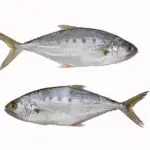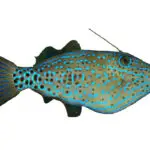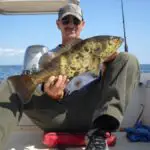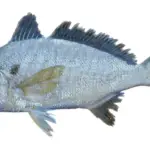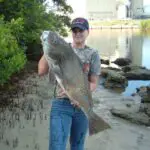While Florida may be known for more ‘prestigious’ fish like snook, sailfish, bonefish or permit…don’t overlook the humble sheepshead.
In this article I’ll go over where to catch them, types of habitat to look for, the best bait, and more tips and tricks for targeting these under-rated fish.
Read on for the complete guide to sheepshead fishing in Florida!
Table of Contents
- Where in Florida Can You Catch Sheepshead?
- How To Find, Target, and Catch Sheepshead in Florida
- Best Tackle For Sheepshead
- Best Baits for Florida Sheepshead
- Spearfishing and Bowfishing for Sheepshead in Florida
- Frequently Asked Questions:
- Final Thoughts & Advice
- Related Posts
Where in Florida Can You Catch Sheepshead?
Sheepshead can be found throughout the coastal waterways of Florida, and congregate in areas near dock pilings and other underwater structures covered in marine growth. Notable hot spots include Jacksonville Beach, Siesta Key, and the Destin Bridge.
Florida’s East Coast
Toward the top of Florida’s East Coast, sheepshead can be found all over the Jacksonville area, within the Jacksonville Beach Pier and St Johns River inlet in Mayport. Further south, Ponce Inlet just south of Daytona Beach is a well-known sheepshead hotspot.
New Smyrna, Port Canaveral and Sebastian Inlet and the surrounding waterways are all excellent areas to catch sheepshead.
And of course, I have to toot the local waters where I often fish…The Indian River Lagoon! This giant estuary has some incredible sheepshead fishing if you know where to look.
South Florida
The South Florida area is also teeming with sheepshead and can be found in almost all of its many many inlets and channels. Much of the Miami area is full of inshore areas that are covered in bridges, seawalls, and other structures that sheepshead love gathering around.
It should come as no surprise that sheepshead can be found all throughout the Florida Keys, along with thousands of other species of fish. Marathon Key and Key Largo are both known for good sheepshead fishing, and there is no shortage of bridge pilings in this region!

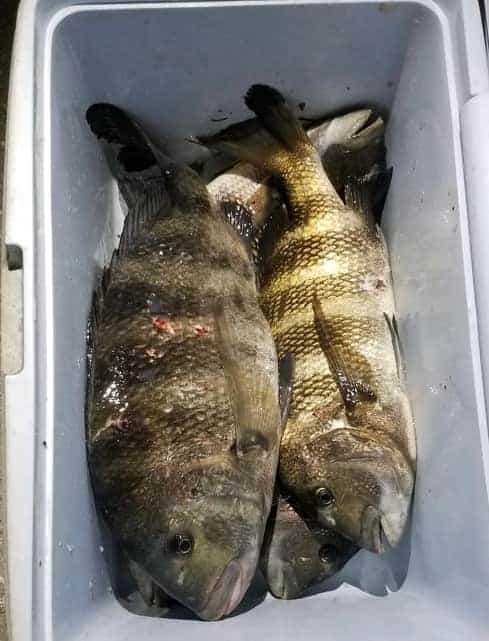
Florida’s West Coast
Siesta Key is located just off the coast of Sarasota and is known for its pristine white beaches and relaxing atmosphere. Siesta Key is also an angler’s paradise, with the north side of the island being the most productive spot for sheepshead fishing.
Annamaria Island is located just north of Siesta Key and is another well-known fishing hotspot. A bit further up the coast, there are sheepshead all over the Tampa Bay region from St. Petersburg to Bradenton. This massive bay is covered in bridges, docks, and seawalls.
The seawalls that run along the channel between Davis Island and Harbor Island are known sheepshead hangouts, as well as the pilings of the many long bridges that crisscross the bay. The Ballast Point fishing pier runs parallel to a demolished pier, which provides tons of structure.
Florida Panhandle
The beaches along Florida’s panhandle are also teeming with sheepshead, and Destin is one of the top areas to catch them in the entire state. In particular, the Destin Bridge and Destin East Jetty are well-known sheepshead habitats, and are fished by tourists and locals alike!
While sheepshead can be found all over the state of Florida, there are still some guidelines that anglers need to be aware of to successfully locate them. Finding these fish can be a quick and simple process once the angler is able to spot the telltale signs of a sheepshead’s habitat.
How To Find, Target, and Catch Sheepshead in Florida
Sheepshead are most often found near underwater structures that are covered in barnacles and other marine life. To target them, use a small #1 or #2 hook with live or fresh bait such as fiddler crabs, clams or shrimp. Chumming an area may help, and be patient and diligent as their bites are hard to detect.
Finding sheepshead in Florida is fairly easy between the months of December and April, as this is their spawning season and they will be extremely active. Sea walls, jetties, shipwrecks, old docks, and bridge pilings are all great places to find sheepshead, especially in the spring.
When targeting sheepshead cast your bait near one of these barnacle-covered structures, while making sure not to cast too far in where the line can get snagged.

Let the bait sink down slowly, and naturally. Experiment with fishing on the bottom, or keeping it suspended in the strike zone where fish may be present.
To catch a sheepshead, first, you must ensure that the hook is swallowed or firmly in the fish’s mouth. Trying to set the hook too soon can yank it out of the sheepshead mouth and spook the fish.
It takes a little bit of practice to detect the bite of a sheepshead. They do not ‘inhale’ the bait like other gamefish...instead, they actually nibble!
In fact, they can nibble the bait right off your hook. My advice is to give them an extra second or two, and as soon as you feel tension set the hook or begin reeling (if using a circle hook).
Best Tackle For Sheepshead
Most sheepshead anglers prefer to use six to seven-foot rods, classified as either “medium” or “medium-light” action. Rods that are on the stiffer end of the spectrum may not be suitable for these “convict fish,” as they have a light nibble that a more flexible rod can more easily detect.
See Also: What Size Spinning Reel for Sheepshead? Things To Consider!
A braided line is generally helpful in combating line break due to the sheepshead’s large teeth, and anglers use anywhere from 15 to 25-pound test. J-Hooks are best suited for the sheepshead’s mouth and smaller hooks work best, with #1 being the most popular size.
An old angler’s trick that has withstood the test of time is scraping barnacles from a dock piling or seawall to chum the water for sheepshead. The barnacles being scraped off release clouds of scent into the water, attracting sheepshead to the area and making the angler’s job easier.
Best Baits for Florida Sheepshead
Like many other types of fish, sheepshead will generally respond best to live bait. Fiddler crabs, sand fleas, and shrimp are all extremely popular sheepshead baits. Oysters and clams can also be used, and fresh dead or frozen bait can be used when live bait isn’t available.
Shrimp is the most commonly used bait across the entire state of Florida and with good reason. It is affordable, readily available at most fishing piers and bait shops, and most importantly – it works. In fact, the largest sheepshead ever caught was done so using live shrimp.
Live shrimp was used to catch more state record sheepshead than any other type of bait, including the 21 and ¼ pound world record which was caught in New Orleans, Louisiana.
Sand fleas are another fantastic bait option in Florida, as they can be found and caught very easily on beaches all over the state.
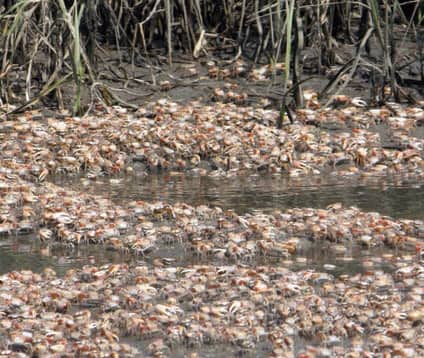
For those who don’t mind a bit of extra effort, grabbing your own sand fleas with a sand flea rake is a great way to save some money on bait, while having a bit of fun in the sand!
There are over 100 different species of crabs that fall under the category of “fiddler crabs,” and sheepshead will eat just about any of them. The multiple rows of a sheepshead’s teeth form a “crushing plate” area that is perfectly suited for crunching and devouring these small crabs.
Oysters and clams also both make great sheepshead bait and can often be gathered for free by resourceful anglers. The sheepshead’s front teeth are used for prying and breaking these shells open to get to their meal. Canned clams are often used in Florida, and provide tons of scent.
Cant find live bait, or in a hurry? It is possible to catch sheepshead on lures too. In fact, sometimes sheepshead only bite lures when nothing else seems to work!
Spearfishing and Bowfishing for Sheepshead in Florida
When spearfishing or bowfishing anywhere in Florida, you must be at least 100 yards from any “public place.” The state of Florida defines a “public place” as anywhere that fishing or swimming is allowed as well as docks, piers, and jetties according to the Florida Fish and Wildlife Conservation Commission.
If done in the proper and designated areas, both spearfishing and fishing can be great ways to bag sheepshead offshore. Divers should stick to shipwrecks, reefs, and other structures, while bow fishers should stick to shallow waters, particularly near oyster bars.
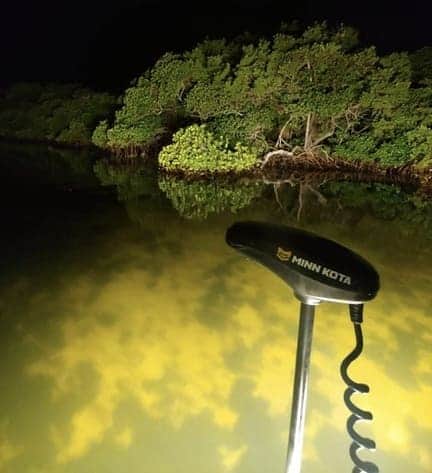
Spearfishing in Florida can be done in the crystal clear waters of the Florida Keys, as well as in muddy, shallow brackish waters. Many boat owners will keep a spearfishing or bowfishing setup onboard for quick access when spotting a sheepshead or snapper.
Bowfishing for sheepshead is becoming extremely popular in the state of Florida, with many fishing charters popping up strictly to accommodate the activity. The Sarasota and Tampa Bay areas are particularly good areas for bowfishing, and there is no shortage of charter captains.
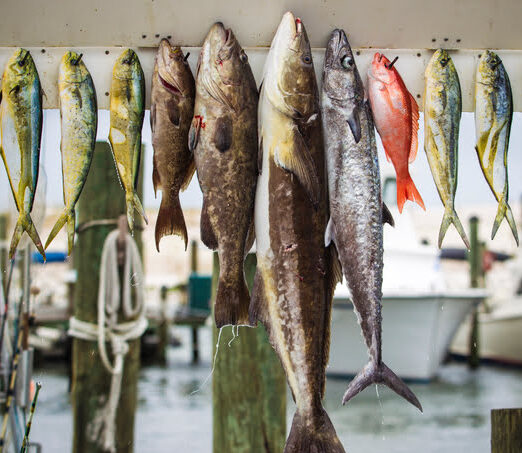
Do You Love Seafood?
Frequently Asked Questions:
Is There a Sheepshead Season in Florida?
There is no designated season for sheepshead in the state of Florida, and they are legal to catch all year long. That being said, any time between the months of December and April will be the most productive for sheepshead fishing across the entire state.
While spawning season sees the highest sheepshead activity, they can be caught year-round for anglers who know where to look. Summer months send sheepshead into deeper waters in search of cooler temperatures, and they can be caught bottom fishing slightly off the coast.
What Is the Limit on Sheepshead in Florida?
Sheepshead must be at least 12 inches to be kept in the state of Florida, and nearly all fishing methods are allowed. Snagging the fish is not allowed, just like with any game fish in the state. It is also illegal to use live or dead bait when combined with a multiple hook setup.
The Florida Fish and Wildlife Conservation Commission states that the daily sheepshead limit per angler is eight, and the limit per boat is 50 during the months of March and April.
Do Florida Sheepshead Taste Good?
Sheepshead are a white fish that is delicious when prepared in a variety of different ways. Many anglers go out of their way to clean and prepare this notoriously hard-scaled and bony fish, finding that the benefits outweigh the extra work.
A common theory around fishing circles is that sheepshead are so delicious to eat because their diet consists of clams, oysters, shrimp, and other sea life that humans also enjoy eating.
However, multiple studies have shown that the sheepshead’s diet can consist of up to 90 percent plant matter, depending on their environment. Regardless of the reason, sheepshead filets are prized cuts of fish, and taste great when baked, grilled, or fried!
What Is Considered a Big Sheepshead?
The average sheepshead weighs anywhere between two and five pounds, making any double-digit catch a very impressive feat. Anywhere past 12 and 13 pounds is flirting with state record territory and is an extremely impressive catch.

While 10 to 15-pound sheepshead are considered to be “monsters,” sheepshead anglers will generally use a 10 to 15-pound test line to target even average-sized sheepshead, due to their ability to damage the line with their large, sharp teeth.
What Is the Florida Record Sheepshead?
The state record sheepshead in Florida weighed in at just 15 pounds and two ounces. E. Lechler managed to land the fish on the state’s gulf coast in Homosassa. While this was certainly an impressively sized fish, it weighed in over six pounds lighter than the world record.
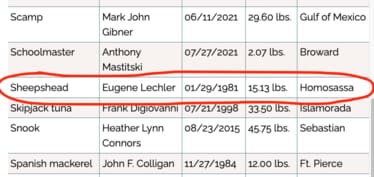
More sheepshead are caught in the state of Florida than anywhere else in the world, making it a bit surprising that a larger one has not been caught since the record was set in 1981.
Final Thoughts & Advice
Florida is one of the leadest states in the nation when it comes to sheepshead habitat and harvest.
And that should come as no surprise, with all of the rivers, inlets, bridges, coves, and estuaries Florida calls home.
Whether you’re trying to catch your first sheepshead, or you’re an experienced angler, I hope the tips in this article help you on your journey.
And remember, fish close to that structure, and if possible, use the local bait.
Have fun!
You May Also Like: The Complete Guide To The Florida Mullet Run

Growing up in Florida, I’ve been surrounded by saltwater my entire life…and I love sharing my passion with others.
To learn more about why I started Saltwater Mecca, visit the ABOUT page.
Thank you for reading this article. Browse around & have some fun!

